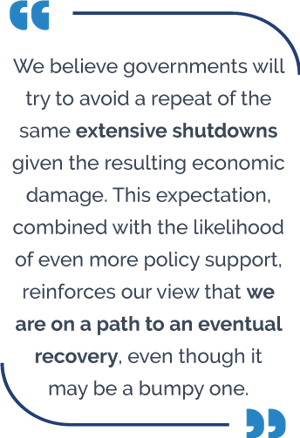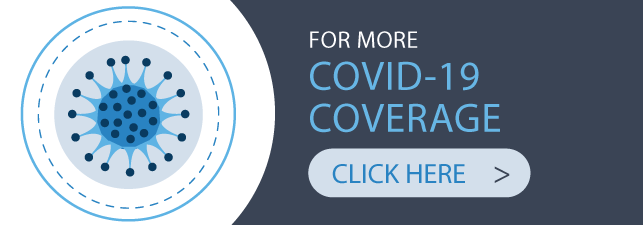1. In March, you anticipated the economy could experience sluggish growth in the third quarter after a downturn in the second. Given the ongoing vagaries of quarantines and shutdowns, has your growth outlook changed?
We still expect to see a substantial downdraft in Q2 growth given the timing of the shutdowns and resultant economic damage. But we believe the worst of the downturn is behind us and we continue to expect recovery in Q3 and beyond as the global economy reopens. Unprecedented policy responses from global governments and central banks should also continue to support global recovery.

We have seen massive monetary and fiscal stimulus, which should help the global economy move out of the downturn and into the credit repair stage of the credit cycle. That said, we believe the breadth and pace of the recovery will remain very uncertain as we wait and watch the stages of reopening. So much depends on how well reopening guidelines—including facemasks, social distancing and contact tracing—prevent new widespread virus transmissions. These measures will be critical to avoid a second wave in the late fall/early winter. The most recent economic releases show a bounce in activity across a variety of indicators, but these capture activity prior to the most recent surges in the southern US states, India, Japan and South Africa. The virus will continue to impact the economy until there is a readily accessible vaccine. However, we believe governments will try to avoid a repeat of the same extensive shutdowns given the resulting economic damage. This expectation, combined with the likelihood of even more policy support, reinforces our view that we are on a path to recovery, even though it may be a bumpy one.
2. Given the uncertainty surrounding the economic recovery, what have you been doing in your portfolios?
We have been active in our portfolios since the market dislocation in March. At that time, we used the volatility to increase our credit exposure, as credit spreads reflected a much deeper downturn scenario than what we thought would materialize. Though the fundamental picture was (and still is) deteriorating, technical factors related to bond fund and ETF outflows pushed spreads significantly beyond our assessment of fundamental fair value. As we discussed in March, we analyze company balance sheets, cash flows and liquidity profiles to invest in companies that we believe are positioned to weather the uncertain environment. Market liquidity improved throughout Q2, and we were able to increase our credit exposure significantly from a fairly neutral starting point in mid-March. We have added positions across a variety of industries; however, we remain cautious and selective around industries directly impacted by the shutdown in travel.
Credit spreads today more fairly reflect the uncertain environment, so we are maintaining our overweight stance. If we were to see another bout of spread widening because of virus growth fears, we have capacity to further increase our credit exposure. We have also marginally increased local rate risk by adding to local markets where there is a relative yield advantage and more room for interest rate cuts than in major developed markets. We remain more measured in our active non-US dollar positions as potential performance will depend largely on the direction of the dollar and the global recovery from here.
3. As the energy sector adjusts to oil around $40, how has it influenced your positioning?
Oil has seen more volatility over this period than almost anything else. The March selloff in the oil price started as a supply shock with Saudi Arabia and Russia not capping their output. Very quickly, the oil demand destruction that occurred due to the global economic shutdown became the more dominant factor. Energy was one of the industries where we increased exposure from the end of March through the first part of Q2. The energy names we bought contributed favorably to our portfolios during that period. But with the strong oil recovery from the lows of mid-April and limited prospect of a rally much above $40, we have since reduced our exposure to energy credits to be more neutrally positioned. We believe $40 oil is a fair value price for a market that still faces a supply/demand imbalance, particularly because the uncertainty around the pace of the economic recovery will only compound the demand challenges in oil markets. We expect it could take two to four quarters for supply surpluses to wind down.
MALR025721
Commodity, interest and derivative trading involves substantial risk of loss. This is not an offer of, or a solicitation of an offer for, any investment strategy or product. Any investment that has the possibility for profits also has the possibility of losses.
Performance data shown represents past performance and is no guarantee of, and not necessarily indicative of, future results.
Market conditions are extremely fluid and change frequently.
This blog post is provided for informational purposes only and should not be construed as investment advice. Any opinions or forecasts contained herein reflect the
subjective judgments and assumptions of the authors only and do not necessarily reflect the views of Loomis, Sayles & Company, L.P. Information, including
that obtained from outside sources, is believed to be correct, but Loomis Sayles cannot guarantee its accuracy. This material cannot be copied, reproduced or
redistributed without authorization. This information is subject to change at any time without notice.




